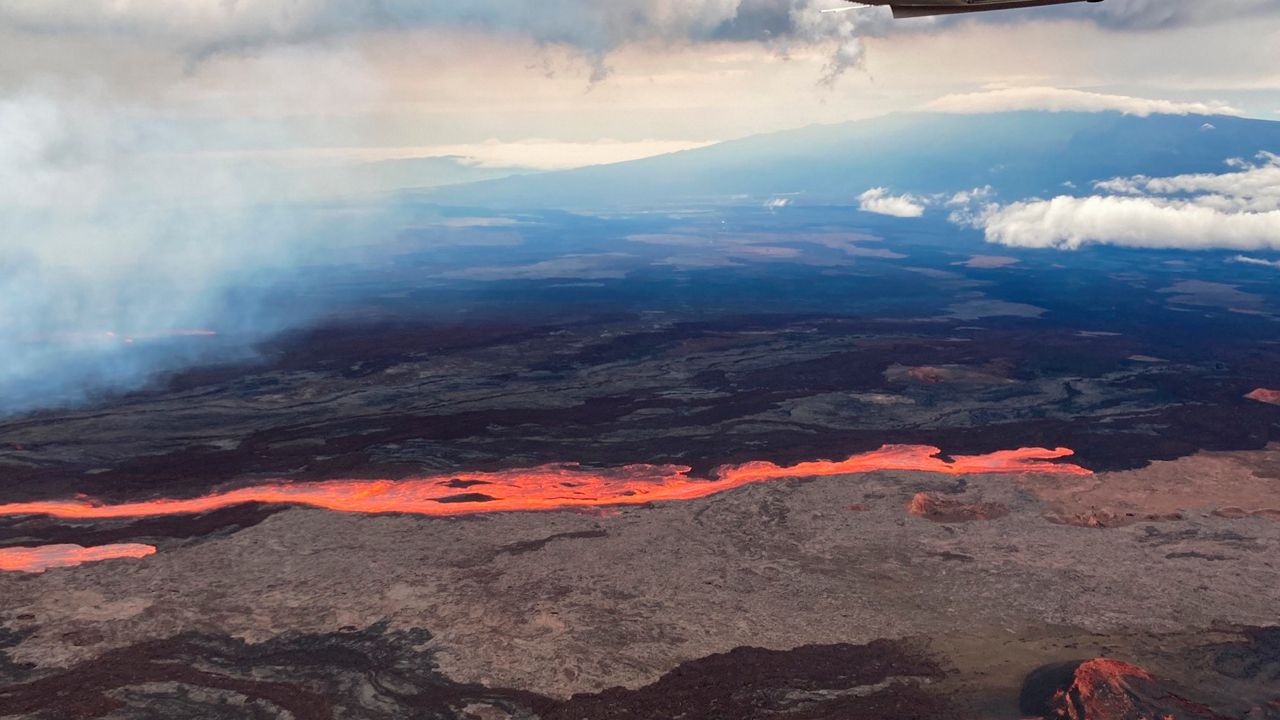Hawaii officials, including Gov. David Ige, held a press conference Monday on the eruption at Mauna Loa, emphasizing that the lava flow is not threatening any homes.
“Lava flows are not threatening any downslope communities at this time,” Ige said.
Ige asked people to stay away from the lava flows, which are in high elevations on Mauna Loa in the northeast rift zone.
He also told residents and visitors to stay vigilant, stay tuned to the County of Hawaii Civil Defense’s updates, and to check the USGS’s website for their most recent post on the status of the eruption.
The Hawaii Emergency Management Agency activated its emergency operation center at 1 a.m. on Monday, according to Major General Kenneth Hara, who is the adjutant general for Hawaii.
Luke Meyers, the administrator for the State of Hawaii Emergency Management Agency, said lava was flowing in a “better direction for impacts to people and property,” but advised the public and visitors “to keep their guard up” as things can change.
The Hawaii National Guard is also on standby, but has not been activated, to help with assessment missions, air and ground evaluations and other requests for help.
Hawaii County Mayor Mitch Roth activated the island’s Civil Defense, and he said he feels confident and ready for the situation.
“Right now it seems like the lava is going to a positive place as far as keeping away from the public and everything like that away from property,” said Roth.
County of Hawaii Civil Defense opened shelters Sunday night in Kau and Kailua-Kona that are being used by families from the South Kona area, even though no homes are currently under threat.
“We will probably review what the populations are in the shelters this afternoon and make a determination what needs to be opened or what needs to be closed down,” said Talmadge Magno, County of Hawaii Civil Defense Administrator.
Ken Hon, the scientist-in-charge at the Hawaii Volcano Observatory, said the eruption started at the summit of Mauna Loa in the Mokuʻaweoweo caldera and covered almost the entire floor of the Mokuʻaweoweo with lava.
The volcanic fissure through which the lava was erupting left the caldera, making it visible to residents in Kona on Sunday night. The lava flow has not yet left the summit of Mauna Loa.
On Monday around 5 a.m., Hon said lava flows and the seismic activity started moving to the northeast. HVO confirmed fissures opened in the northeast rift zone. Historically, a rift eruption lasts one to two weeks, Hon said. That timeline is not guaranteed though, as some eruptions last as long as a year.
“We presume at this point that all of the future activity is going to be on the northeast rift zone of Mauna Loa and not on the southwest rift zone,” Hon said.
It would be more of a concern if the volcanic fissures opened up on the southwest rift zone, because the slopes of Mauna Loa are more populated.
“The northeast rift zone empties into the saddle area; there's no real habitation up there,” he said.
The Pohakuloa Training Area facilities are in the area, but not in the path of where they expect initial lava flows to go.
The Mauna Loa Weather Observatory is also in the area, but lava is not directly threatening it. However, lava flows could sever the road that leads to it.
“In the long term, eventually, this kind of lava flow is very similar to what happened in 1984, and eventually could threaten populated areas around Hilo,” Hon said.
He said it will be at least a week before lava would start heading toward Hilo. In 1984, the flow got close but did not cover the Kaumana subdivision at the upper west side of Hilo, which has expanded little since this time.
“We're hoping that it will parallel the 1984 eruption by becoming more viscous as time goes on, and hitting the flatter slopes around the Saddle to slow it down,” Hon said. “This actually prevented the lava from getting into Hilo.”
By noon on Monday, the eruption was coming from three different fissures, spanning about 1-2 miles each. The lava fountains coming from the fissures were reaching heights of about 100-200 feet.
“They are putting off gas, but not much ash,” Hon said.
The Hawaii Department of Health is monitoring the air quality for sulfur dioxide, according to Dr. Libby Char, the director of health.
“Right now our air quality seems to be good,” she said.
She added people should stay away from the lava flows, because face masks — N95s, KN95s — will protect from ash, but they do not provide any protection from the gasses.
“It can be very, very dangerous,” Char said.
Hon added that over the next two weeks, he expects the air quality to deteriorate.
Michelle Broder Van Dyke covers the Hawaiian Islands for Spectrum News Hawaii. Email her ideas and feedback at michelle.brodervandyke@charter.com.



